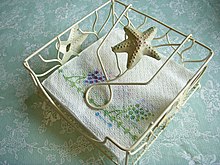napkin
A napkin is part of the table linen and consists of fabric (cotton or mixed fabric), fleece, paper or tissue. A distinction is made in gastronomy according to purpose:
The mouth napkin (obsolete mouth cloth or plate cloth ) is a cloth that is used during and after a meal to dab the lips, wipe the fingers and cover clothing to protect against contamination. An artistically broken napkin marks the seat, it is folded once before the first drink or before the meal on the lap, the break points to the knee.
The hand napkin (also known as a service towel ) protects the arm or hand when applying hot objects and is used not to leave fingerprints on the dishes or to easily remove bottles from the wine cooler.
A top napkin is a synonym for a middle cover .
history
The term serviette was taken over from the French, "the little servant" ( Latin servus = slave, servant). First, the plates of diners hence the old German expression were wiped with the napkin by the officials, dish cloth , still in the Encyclopedia of Johann Georg Krünitz is included.
The serviette (lat. Mappa ) is already an integral part of the Roman banquet and has been well documented since the 1st century. The representations, which became more frequent from the 3rd century onwards, show two variants. Once a cloth of approx. 50 × 50 cm on the dining table to protect the covers, as well as a slightly smaller, usually held in the left hand mouth cloth.
In the 16th century, napkins were first reintroduced to the nobility . In the Middle Ages, fingers were wiped on clothing or on the tablecloth.
From the Middle Ages until today, the decorative folding of napkins (" breaking napkins ") has developed into an art form in its own right. The napkin ring saves this hassle and makes it easier to store it until the next meal.
Appropriate use
At an official meal, the cloth napkin will only be picked up if the hostess does. At the latest for the starter, the napkin is folded square and placed on the thighs, offset by one centimeter so that it can be better grasped. If the guest leaves the seat, he folds the cloth napkin and places it on the left of the plate.
material
Cloth napkins
In upscale gastronomy and on special occasions, fabric napkins made of damask are used, which are made either from pure cotton or from a cotton- linen blend. The linen mix and the usual starches give the napkin a special stand.
Paper napkins

Paper napkins, which consist of several layers of cellulose and are available in different quality levels and designs, are very common .
Much smaller paper napkins have become common in simple restaurants and food stalls . Even in better restaurants , cellulose napkins are no longer uncommon.
In addition to the pure white paper napkins, there is also an immense variety of brightly colored variants. According to the Federal Institute for Risk Assessment, these are suspected of releasing primary aromatic amines that are harmful to health as a decomposition product of the azo dyes used for dyeing , which is why they should not be used for wrapping food if possible.
The first paper napkins were probably used in Japan ( rice paper ) and were primarily used for cleaning chopsticks .
Folding technique
Napkin breaking or napkin origami stands for the decorative folding of napkins. It is often used for table decoration in gastronomy. Usually a square napkin made of linen or cotton is used. There are variations with rectangular napkins or accessories such as napkin rings or drinking glasses.
Well-known variants are:
|
|
|
literature
- Joan Sallas: Tischlein deck dich: Catalog for the "Exhibition Tischlein deck dich in the Salzburg Baroque Museum, July 2 to October 26, 2008"; Origin and development of napkin breaking , Freiburg im Breisgau [u. a.], 2008 ISBN 978-3-901925-31-3
- Joan Sallas: Pleated Beauty. The art of breaking napkins , Freiburg im Breisgau and Vienna, 2010 ISBN 978-3-00-032495-6
Web links
Individual evidence
- ↑ Service customer & guest care. Table linen. In: Europa-Lehrmittel . Accessed March 31, 2019 .
- ↑ Duden | Table linen | Spelling, meaning, definition. Accessed March 31, 2019 .
- ↑ a b welt.de: How to save yourself from embarrassing napkin mishaps
- ↑ Primary aromatic amines from printed food contact articles such as serviettes or baker's bags . Unconditional. Retrieved September 2, 2014.
- ↑ Colored napkins: Not always suitable for contact with food! . cvua Stuttgart. Retrieved September 2, 2014.
- ^ Kuhn, Doris (2005). Napkin Folding for Every Occasion. New York: Sterling Publishing. p. 9. ISBN 9781402728020 . "It is no accident that fine restaurants have long preserved the art of napkin folding as an important element of presentation."
- ↑ Napkin Folding Ideas . Marthastewart.com. Retrieved May 7, 2013.


